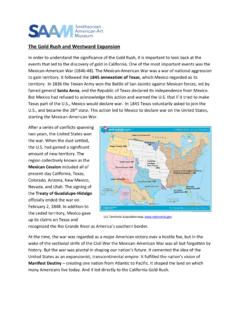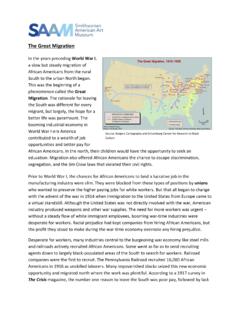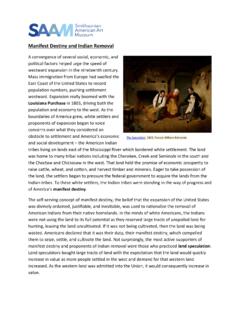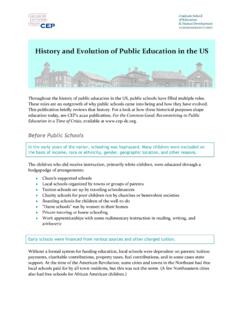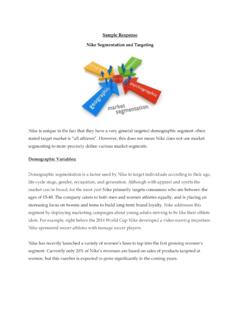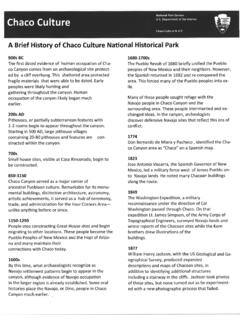Transcription of The Jim Crow South - American Experience
1 The Jim crow South Though the Reconstruction era (1865-1877) had sought to right the wrongs done to African Americans during slavery, not much had changed in the way of their civil rights after Reconstruction ended. In fact, the civil rights of blacks began to be further impinged upon by a series of laws, collectively called Jim crow laws, designed to segregate, discriminate, and intimidate. The tightening of segregation began with sharecropping. The Southern economy was dominated by agriculture. The few factories and mills that did exist preferred to employ white labor over black labor. Consequently the majority of freed African Americans were forced into sharecropping a system of agriculture in which a landowner allows a tenant to use his land in return for a share of the crop produced on that land. Former slaves had expected that the federal government would provide them with land as compensation for the work they had done before emancipation.
2 A plan known colloquially as forty acres and a mule, whereby each formerly enslaved family would receive not more than forty acres of tillable ground. However, President Andrew Johnson enacted a Reconstruction law which ordered that all land under federal control be returned to its previous owners the white landowners. Freed slaves were informed that they either had to sign labor contracts with the landowners or be evicted from the land. The Civil Rights Act of 1875 was meant to guarantee freed blacks equal treatment in public accommodations such as hotels, public transportation, and theaters. But in 1883, several provisions of the Act were ruled unconstitutional by the Supreme Court in a group of five cases collectively called the Civil Rights Cases. The majority rule held that the provisions were unconstitutional because Congress did not have the authority to regulate private affairs under the Fourteenth Amendment, which protected a person s civil rights from being violated by the state, not by individuals such as when a hotel refused to rent a room to an African American .
3 The Supreme Court held that the Act addressed social rather than civil rights, and was consequently invalid. Employment of Negroes in Agriculture 1934, Earle Richardson, Smithsonian American Art Museum The Supreme Court s decision created a ripple effect across the South . State legislatures began enacting laws legalizing segregation in public places. Those Jim crow laws imposed segregation and denied African Americans equality and political rights. The Supreme Court upheld these Jim crow laws in the 1896 landmark case Plessy v. Ferguson, which maintained the constitutionality of the separate but equal doctrine. New Orleans: Segregation in the Deep South Following the end of Reconstruction, New Orleans became increasingly segregated as Jim crow laws were introduced by law makers who wanted to see the South returned to the days of white privilege that existed before the Civil War. Between 1900 and 1950 New Orleans population grew slowly, yet shifted dramatically.
4 A city with once heterogeneous communities became increasingly segregated under Jim crow . Ironically, New Orleans did not start out as such a segregated city. In the early nineteenth century New Orleans population was increasingly diverse, divided evenly into thirds: white, free people of color, and slaves. This can be attributed to New Orleans unique geographical location. A port city, it received slaves as part of the Triangular Trade routes. It remained a transportation hub throughout the first half of nineteenth century with New Orleans booming cotton economy. Yet segregation was fully entrenched in New Orleans when artist Jacob Lawrence arrived there in 1941. Segregation in public housing created by the New Deal and on a new street car system kept whites and blacks further apart. Legislation required that Lawrence ride in the back of city buses and live in a racially segregated neighborhood. The artist experienced firsthand the daily reality of Jim crow segregation, which he captured in Bar and Grill and other paintings that dealt with what he called the life of Negroes here in New Orleans.
5 As an African American who grew up in the North, Lawrence only had secondhand knowledge of the South , yet he felt connected with the region s culture through association. He later remarked, Any Negro person A caf near the tobacco market, Durham, North Carolina, depicting separate white and colored entrances, 1940, Jack Delano, Courtesy of the Library of Congress has a strong relationship to the South .. Your life had a whole Southern flavor; it wasn t an alien Experience to you even if you had never been there. Most bars in 1940s New Orleans were entirely segregated each whole establishment being reserved exclusively for white patrons, or for black patrons. Jim crow laws had re-established the literal and figurative wall between blacks and whites. It is in this climate that Jacob Lawrence painted Bar and Grill, conjoining separate, segregated businesses into one bar divided down the middle, between black and white patrons.
6 The message that blatant segregation and systematic racism was a reality in the American South seems clear. Leaving the South Many African Americans were eager to escape the legal system in the South and the miseries it caused for black citizens. By law, African Americans were denied access to the same institutions that were used by whites, like hospitals and schools. They also had few legal rights. Whites could assault or even kill blacks with little fear of being tried in a court of law or imprisoned. The discriminatory Jim crow laws helped to perpetuate a social and economic system that kept Southern blacks subjugated. The majority of Southern African Americans lived in poverty. Those who did manage to obtain an education or excel at a profession risked becoming victims of violence by whites who did not want to see them rise above their supposed position. Many young African Americans who made the decision to journey north had experienced the hardships of life on sharecropper farms, subjected to Jim crow laws, and abuse and intimidation from the Ku Klux Klan.
7 They saw how their parents generation were subjected to the injustices of Southern society. Their reasons for migration were numerous, but overall, the desire to better their condition prevailed above all else they wanted to Experience the freedom and opportunities that the North offered. At this time in the country s history, industrial expansion created economic opportunities for these rural migrants. And opportunities were only growing for blacks in the North with the onset of World War I expanding the booming industrial economy. The stage was now set for the Great Migration. The Way We Was, 1990, Herbert Singleton, Smithsonian American Art Museum Glossary Andrew Johnson: (1808-1875) 17th President of the United States. He became president on the death of Abraham Lincoln, having served as Lincoln s vice president. His plans to restore the seceded states to the Union without protection to former slaves led to his impeachment by the House of Representatives.
8 Civil Rights Act of 1875: a federal law enacted during Reconstruction which intended to guarantee freed blacks equal treatment in public accommodations, such as hotels, public transportation, and theaters. The bulk of the law s provisions were ruled unconstitutional in 1883 by the Supreme Court. forty acres and a mule: a concept of land redistribution for freed slaves, whereby Congress authorized the Freedman s Bureau to oversee the rental of 40 acre parcels of abandoned or confiscated farmland (formerly owned by Southern plantation owners) with the eventual option to purchase. Fourteenth Amendment: (1868) granted citizenship to all persons born or naturalized in the United States, which included former slaves recently freed. In addition, it forbids states from denying any person "life, liberty or property, without due process of law" or to "deny to any person within its jurisdiction the equal protection of the laws.
9 Great Migration: (1910-1930) the first wave of African American migration to the North from the South . Jim crow : state enforced segregation and disenfranchisement laws against African Americans; enacted after the Reconstruction era. The term Jim crow originated in vaudeville-type traveling stage plays where Jim crow was an African American stock character, a stereotypically shiftless buffoon designed to elicit laughs with his dancing ability and avoidance of work. Ku Klux Klan: founded in 1865, a post-Civil War secret society which advocates white supremacy and terrorizes minority groups, primarily African Americans. Plessy v. Ferguson: a 1896 Supreme Court case which upheld the constitutionality of the separate but equal doctrine. The case stemmed from an 1892 incident in which Homer Plessy refused to sit in a Jim crow car of a passenger train, breaking a Louisiana law. The Court rejected Plessy s argument that his constitutional rights were violated, ruling that the state law that implies a legal distinction between whites and blacks did not conflict with the Thirteenth and Fourteenth Amendments to the Constitution.
10 The decision in Plessy v. Ferguson was not overturned until Brown v. Board of Education in 1954. sharecropping: a system in which freed blacks rented plots of land in return for giving a portion of their crop yield to the landowner (often their former master.) subjugated: to have been made subordinate or inferior; having been subject to the dominion or power of someone else. Triangular Trade: a pattern of commerce in the trans-Atlantic slave trade in which European textiles, rum, and manufactured goods were used to purchase African slaves; African slaves were sent to the West Indies and America to produce colonial exports; these exports (sugar, tobacco, and cotton) were shipped back to Europe.
